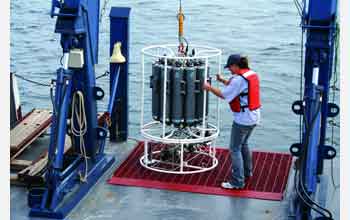Multimedia Gallery
ATE Centers (Image 6)
Interns participate in a Marine Advanced Technology Education center program. MATE programs seek to engage educational and industry organizations in collaborative activities such as at-sea internships. [Image 6 of 12 related images. See Image 7.] (Date of Image: 2009)
More about this Image
The mission of the Marine Advanced Technology Education (MATE) center--funded in part by a grant from the National Science Foundation's (NSF) Advanced Technological Education (ATE) program--is to help prepare America's future workforce for ocean-related occupations. The center utilizes information from employers to improve and develop educational programs with a focus on marine technology. The center focuses on community college education and the creation of strong links between community colleges and high schools, technical schools, four-year institutions, research institutions and industry, government, military and labor organizations.
MATE works in partnership with over 200 educational institutions and over 200 companies, government agencies, professional societies and individuals to accomplish its mission. Working with educators, employers and people currently working in the field, the center is developing educational and training programs that provide the skills, knowledge and abilities needed to succeed in a technically challenging workplace. In addition to monetary contributions, these partners have given in-kind contributions, including access to facilities and equipment and the donation of employees' time to support workforce development projects, student internships, faculty workshops and the center's remotely operated vehicle (ROV) competitions.
The regional and international ROV competitions sponsored by MATE challenge students to apply the physics, math and electronic and engineering skills they are learning in the classroom to solve practical problems from the marine workplace. ROV competitions encourage students to develop project management, technical writing, communication and teamwork skills that they utilize to prepare technical reports, poster displays and engineering presentations that are delivered to technical professionals, helping to solidify the connection to real-world industry practices. The MATE center is located at Monterey Peninsula College in California. To learn more, visit the center's website Here.
NSF's ATE program supports efforts to improve the knowledge and skills of technicians who work in high-technology fields that drive the nation's economy. The program focuses on undergraduates, secondary school students and incumbent technicians, as well as on the educators who teach them. Community colleges are the main providers of education for technicians and have leadership roles in all ATE initiatives, working closely with industry, government and educators in other sectors to enhance the skills of the men and women who are essential to the vitality of the nation's economy. ATE partnerships help create new curricula; reform existing programs; enrich the technical knowledge of experienced college faculty members and teachers; prepare prospective educators with solid foundations in science, technology, engineering and mathematics; and undertake applied research in technological education. Further information on NSF's ATE program is available Here.
Credit: Photo from ATE Centers Impact 2008-2010 (www.atecenters.org)
Images and other media in the National Science Foundation Multimedia Gallery are available for use in print and electronic material by NSF employees, members of the media, university staff, teachers and the general public. All media in the gallery are intended for personal, educational and nonprofit/non-commercial use only.
Images credited to the National Science Foundation, a federal agency, are in the public domain. The images were created by employees of the United States Government as part of their official duties or prepared by contractors as "works for hire" for NSF. You may freely use NSF-credited images and, at your discretion, credit NSF with a "Courtesy: National Science Foundation" notation.
Additional information about general usage can be found in Conditions.
Also Available:
Download the high-resolution JPG version of the image. (2.9 MB)
Use your mouse to right-click (Mac users may need to Ctrl-click) the link above and choose the option that will save the file or target to your computer.

